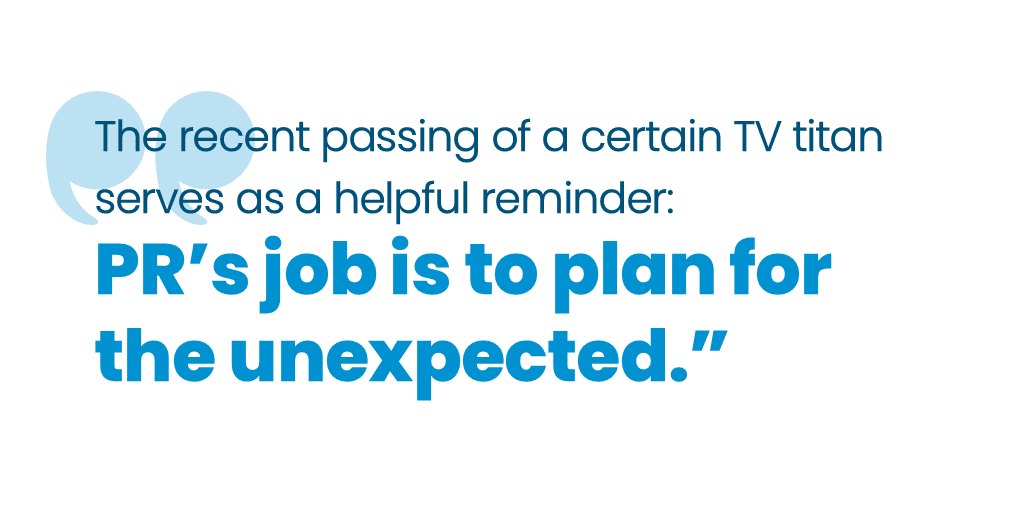
Not dead yet: Legacy planning to prepare for the expected–and sometimes unexpected–death of a key leader
The TV series Not Dead Yet features a journalist turned obituary writer who is visited by the ghosts of her subjects. Like the fictional character, real life obituary writers sometimes write about their famous subjects while they are still alive. While it may sound creepy, it’s not a bad model for comms professionals who may be faced with sharing news of the passing of an aging company leader.
[Spoiler alert — stop reading if you have yet to watch the final season of Succession!]
In this year’s final season of the popular show Succession, the flatfooted reaction portrayed by the fictional corporate comms characters and family members to the bombshell news about the family patriarch could have used a page from this playbook. The chaotic response felt real but given Logan Roy’s prior near-death experience in an earlier season, it seemed like PR malpractice for the team to be so unprepared.
Communicating about the death of a co-worker, especially one that is unexpected, is unpleasant. When it is the founder of the company or a well-known professional, it can be especially fraught as people think through the broader implications of the loss.
The passing late last year of Scott Minerd, the well-known CIO of Guggenheim Partners was a reminder of the challenge faced by a company when a prominent leader dies unexpectedly.
Companies must move quickly to share the news, craft a statement that is at once sensitive to the immense loss family and coworkers are dealing with while addressing the business implications of replacing a trusted and important member of the team. As with any crisis, communications professionals must coordinate with other leaders in the organization, all while dealing with the grief of losing a coworker or even a friend or mentor.
Planning for the expected
Not unlike the obituary writers who anticipate and pre-write tributes to world leaders or celebrities, anticipating and planning communications for a key leader’s passing is only prudent. We’ve counselled firms before on how to be prepared—and how to be discreet about it. While a lot of work will still happen in real time, when the sad news eventually comes, you will be grateful not to have to pull something together at a trying time.
Like a crisis communications plan, pre-planning for the passing of key leaders should include several elements:
Start with who. Identify the key people who will need to be informed. For large companies, this will include a prioritized list of affected constituencies internal and external to the firm:
- Immediate co-workers and direct reports
- Boards of directors
- Executive leadership
- Broader employee population
- Clients ranked by the degree of contact with the key leader
- Key external partners—attorneys, accountants, consultants and others who worked closely with the leader
- Media
- Community leaders
List the communications needed. The next step is to identify the various communications that will be needed. For financial services firms, keep in mind that an unexpected death might require regulatory filings such as a prospectus sticker.
- Brief website announcement
- Internal announcement for board, employees
- Client communications or letter
- Longer tribute
- Social posts linking to the internal announcement
- News release/media announcement
- External communication to key partners, vendors, etc.
- Talking points for internal staff who may take questions from clients or others
Create your core draft. While it may not be necessary to draft each of these pieces, it helps to prepare one core piece that addresses the highlights of the leader’s life and important contribution to your firm. This core piece can later be updated and modified for each of the various audiences. This piece needs to be circulated ahead of time to your inner circle of VIPs to mark gaps that will need to be filled in and addressed when the eventual passing occurs. This piece should also be regularly reviewed and updated.
Do you include the key leaders who are the subject of this pre-planning in the discussions? You can, and many may appreciate and feel relieved that a plan is in place. For others, it might be more difficult if not outright awkward. The truth is that this planning can be done with or without the input of these executives. Whatever you prepare in advance is just a helpful start and the final version, when it actually is needed, will likely be revised and updated.
Dealing with the unexpected
When a firm founder or key leader celebrates a key milestone birthday, creating a plan and drafting a few communications makes sense. What is more challenging is the unexpected death, like Minerd’s. In our experience, these traumatic events often happen at the worst time. And whether they are on holiday or a long-planned vacation, communications professionals recognize the need to drop everything and move quickly to fill the vacuum created by an untimely death.
Here, creating a small group to help execute these communications is critical. This group should include executive leadership, the general counsel or senior legal representative and whoever is likely to be named successor to the departed leader, if known. Like the pre-planned communications above, start by identifying the list of who needs to know and the communications that need to be created. Then move quickly to identify the core information you will need to include in your communications:
- The leader’s professional history
- The contribution they made to your firm
- Hobbies, community involvement and activities outside of work
- Details of how you plan to fill the gap created by the death
- A list of the family and key personal relationships
Once you’ve gathered the key information, begin by drafting one core piece such as an internal announcement or tribute. This must include the details of the leader’s passing and a statement or quote from the senior-most leaders of your firm. Circulate this draft to your core group to get immediate feedback. From there you can modify and build out other core communications elements for the team to review. As with any sensitive announcement, comms leaders must manage the details, oversee version control and remain disciplined to assure appropriate sign off and the delivery of final versions to the right audiences.
These times can be among the most trying a communications professional will face. But they are among the most important. Few regret the long hours and foregone plans when a crisis of this nature calls.
Just as quarters and years all come to an end, the passing of a colleague is an eventuality to anticipate. It can be a time of major grief and upheaval at the highest levels of your organization. The preparedness of your communications team can provide comfort and confidence that your firm is putting its best foot forward. Getting this exercise underway is delicate, we know, and sometimes bringing in outside expertise for direction can be helpful. If this kind of communications plan has been on your mind, please reach out and we’d be honored to serve as your guide.
Lowe Group offers a range of services related to public relations, send us a note for more information
Subscribe.
Receive the latest news and insights from Lowe Group.
